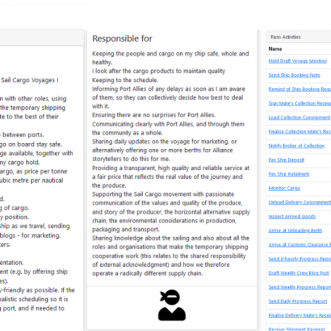
Why create a Customer Experience Score?
Why write down your Customer Experience Score? I can think of at least 6 reasons:
- Memory.
- Without a Customer Experience Score, some of the knowledge of “what we do here” and as importantly, “how we do things round here” and “why we do what we do” gets lost every time one of your ‘good people’ leaves. This knowledge also gets changed as new people join and bring their previous experience with them.
- This can be overcome by a founder that spends time and energy ‘policing’ the culture (think Steve Jobs), but one day even the founder will disappear.
- A Customer Experience Score gives your business a memory of its own, outside the heads of the people in it – including you.
- That memory needn’t be prescriptive. The most detailed score still leaves room for interpretation, and you can make it more improv if that’s your style, but the main thing is that if the business always remembers the “what”, “how” and “why”, your people don’t need to make it up as they go along.
- Detachment.
- As Japanese businesses know well, what I call a Customer Experience Score embodies the ‘thing’ a group of people are working on – whether that’s a play, a car, a building or a service.
- This allows a certain level of separation between ‘what I am trying to achieve‘ and ‘who I am‘, which makes it much easier for everyone involved to discuss and agree improvements, because it’s ‘the thing’ that’s being judged, not ‘me’. Free from the fear of personal criticism, your good people can eagerly look for ways to make things better.
- Confidence.
- Having a Customer Experience Score to follow while they learn, gives people confidence that they are doing the right thing.
- Once people are confident that they know what they are doing, they don’t wait to be made accountable – they take responsibility. With the confidence of a process behind them, your good people can pretty much manage themselves.
- Emotion.
- Most modern businesses, large and small, involve interactions of some kind – with other employees, customers, and suppliers.
- These interactions require emotional labour – listening; empathising, being present to the other person as well as intellectual labour – pattern-matching, imagining potential scenarios, reviewing possible solutions etc..
- Without a Customer Experience Score these interactions become harder than they need to be, because every interaction is treated as unique, where in fact they fall into common patterns, with unique features.
- Your Customer Experience Score captures what has to happen in the common patterns, giving your people a framework to work from that doesn’t need much thinking about.
- A Score frees up intellectual and emotional energy to be spent on the unique and personal aspects of regular interactions, and on the exceptions that either prove the rule, or highlight the start of a new pattern. With their heads cleared of the routine, your good people can use their hearts to do more than keep your promises – they can confidently exceed them.
- Automation.
- The hardest part of automating any process or function is specifying exactly what it is you’re trying to do. This is so hard that most people skip this step, trusting the software to do this job for them. The trouble is, off the shelf software is by necessity, targeted at a mass market, while you have your own unique way of making and keeping promises. This means either conforming to the way everyone else does things, or worse, automating the details, without understanding the process as a whole. With a Customer Experience Score, you can use automation (even off the shelf) to strengthen your uniqueness, not dilute it.
- Longevity.
- Not even I would say that a Customer Experience Score can be designed to deal with every possible scenario, exception or eventuality, and without good people a Score-based business gradually fossilises and becomes irrelevant, or worse, gets completely out of step with its environment.
- Good people can handle exceptions appropriately when they occur. They can also identify when those exceptions are due to environmental changes that need to be dealt with by adjusting the Score.
- Good people spark off constraints (such as a process), they ad-lib, improvise, invent workarounds, dream up ridiculous scenarios that open up new opportunities. With a solid framework to play in, good people bring a business to life – they make it human. A Customer Experience Score enables people to keep your business alive and human for generations to come.
Discipline makes Daring possible.










